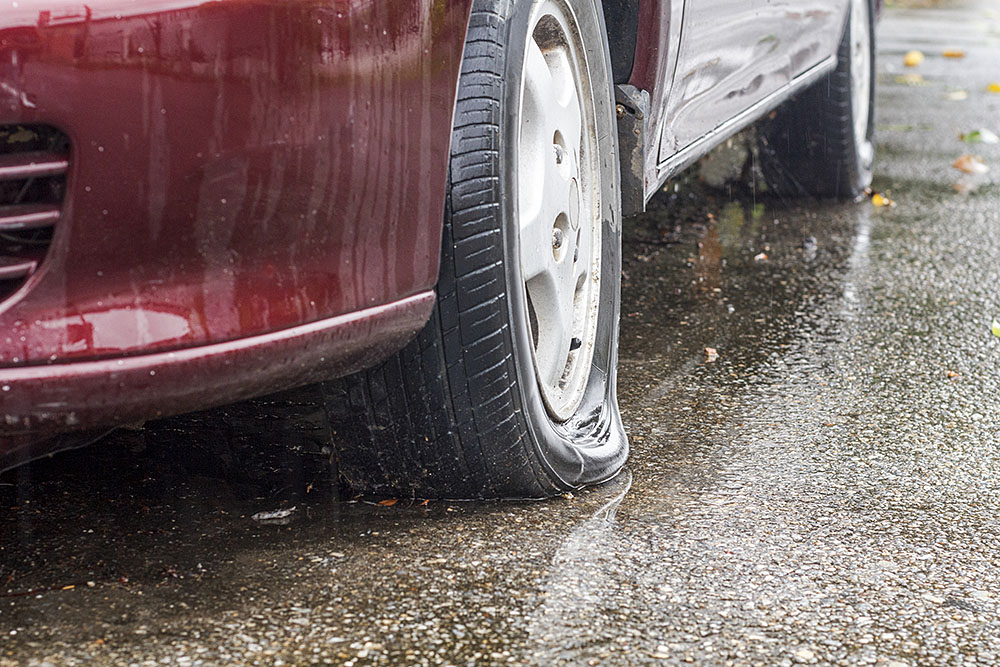Deflated By December Weather? Get Those Tires Inspected

Modern vehicles offer tire pressure monitor systems (TPMS), but they are far from a perfect solution.
“TPMS systems have limitations and should not be relied on as the sole source of information,” Jamieson said. “Sometimes a gauge won’t light up until the tire has gone 25 percent below factory recommendations or when all tires are gradually losing air pressure.”
“Whether you’re traveling 20 or 2,000 miles, proper tire pressure, in addition to regular maintenance, helps keep you and your family safe on your next road trip,” Jameison said.
“Keep a tire pressure gauge in your vehicle to make sure you are getting a consistent reading each time, instead of information from multiple gauges at different gas stations,” he said. “And don’t forget to check the spare tire every time.”
How do you gauge accurate tire pressure?
Heat causes air to expand, making measurements from a warm tire unreliable. This is also why air shouldn’t be added to warm tires.
Test the tires when they haven’t been driven on for a few hours. Cold tires provide the most accurate reading.
Hint: You can’t tell simply by looking.
“A tire can lose half its pressure without looking flat,” said Scott Jamieson, director of product management for Cooper Tire. “It’s not something you can visually estimate. Checking a tire’s air pressure is simple, but you need the right tool.”
Underinflated tires are more prone to tire blowout since they are riding on the thin outer edges of the rubber. They also create uneven wear patterns that diminish tire life.
According to Jamieson, underinflation by even 8 psi can reduce tire lifespan by 9,000 miles. That can account for one-third to one-fourth of a typical tire lifespan--or as much as 25% of your tire cost.
Overinflated tires also are a potential problem.
“Over-inflated tires are at-risk for cutting or puncturing upon impact with a curb or object in the roadway,” Jamieson said.
Every manufacturer recommends a specific air pressure for individual models. The figure is found in the owner’s manual and the inside panel of the driver’s side door. Jamieson suggests getting the air pressure in your tires checked monthly and before long drives.
Jameison shared the following insight about the importance of tire pressure and how to get it right.
- Check tire pressure monthly. Always check pressure before long trips.
- Remember to check your spare tire as well. It’s an easy thing to forget but an important safety precaution, especially for families going on long drives.
- Test with a gauge when tires are cool. That gives you the most accurate reading. Usually, that means your tires have not been driven for at least two hours. Air expands as it heats, and checking a hot tire gives an inaccurate reading. For the same reason, don’t add or reduce the amount of air in a tire when it’s hot.
- Improper inflation can damage tires. Tires that are over- or under-inflated can wear unevenly, causing bald spots that diminish the tire’s lifespan.
- Have your tires properly inflated every time they are rotated. Service centers will typically inflate your tires to the manufacturer’s recommendations during a rotation. But ask them to perform check the air pressure just in case.
- Don’t rely on tire pressure monitoring systems. The systems typically are designed to trigger alerts when tire pressure drops critically low. For example, some systems don’t set out a notification until the air pressure has dropped to less than 25 percent of the manufacturer’s recommended tire inflation.